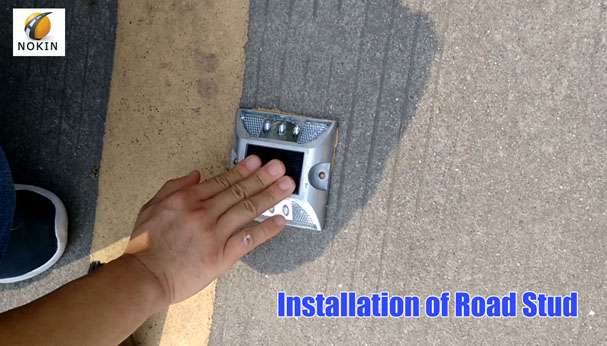For the solar road studs can delineate the roads and increase the security in night-driving, the solar road studs are widely applied in recent years. A solar road stud with high quality should possess the features as follow: strong pressure resistance, continuous high brightness, and firm installation, however, the first two elements are paid more importance in the using of solar road studs, and the last element is neglected, which causes high expulsion rate of the solar road studs in short time of service. The following aspects should be noticed in the installation process:

Video:Method of Installation of Solar Road Studs
1. Location
The installation site of the solar road studs should be clean and tidy, which can increase the contact area between the solar road stud and the ground to increase the adhesive force.
2. Adhesives
1) Choosing of adhesive. The main adhesives mainly used now are asphaltic mastic and epoxy resin adhesive. The advantage of the asphaltic mastic is short curing time, but there is a fatal weakness, and that is it will soften when the surface temperature reaches 70 to 80℃ in summer, and the solar road studs will come off the ground, or the black adhesive will come to the surface of the reflectors to influence the reflective effect of the solar road studs. So the resin epoxy adhesive must be used in the installation of solar road stud. There are more than 100 resin epoxy adhesives sold in market, but only two to three types which are suitable for the solar road studs and the proportion of the adhesives must be appropriate.
2) The mixture of the resin epoxy adhesive, curing agent, and the cement is quite viscous, especially in winter, however, these three components must be mixed fully with the mixing gun to make the mixture can solidify the solar road studs firmly on the ground.
3) Paste the adhesive on the ground and press the solar road studs tightly on the ground. The amount used must be reasonable: the solar road studs cannot be installed firmly if too less adhesive is used, and it is a waste of adhesive and may dirty the reflectors if too much is applied.
3. The installation section should be closed
The resin epoxy adhesive can solidify after 6 hours, so the installation section of the road should be closed for 6 hours.
4. Problems should be noticed for the cast aluminium solar road stud with foot
1) The hole is too shallow, and the back of the solar road stud cannot contact with the ground fully, which may has influence on the firmness of the solar road stud. So the depth of the hole dug should 1cm deeper than the length off the foot of the solar road stud.
2) The hole is too thin, and it will be difficult to install the foot of the solar road stud. So the appropriate drill should be chosen.
3) The dust is not cleaned when install the solar road stud, which may cause the solar road stud cannot be installed firmly on the ground.
It is easily to see that clean ground, appropriate adhesive, fully mixed adhesives and 6 hours’ closing are the procedures should be noticed in the installation process of the solar road studs.
Copyright © 2011-2018 by NOKIN All Rights Reserved.